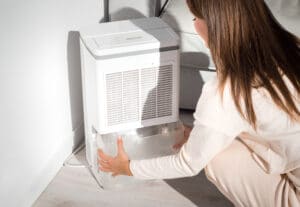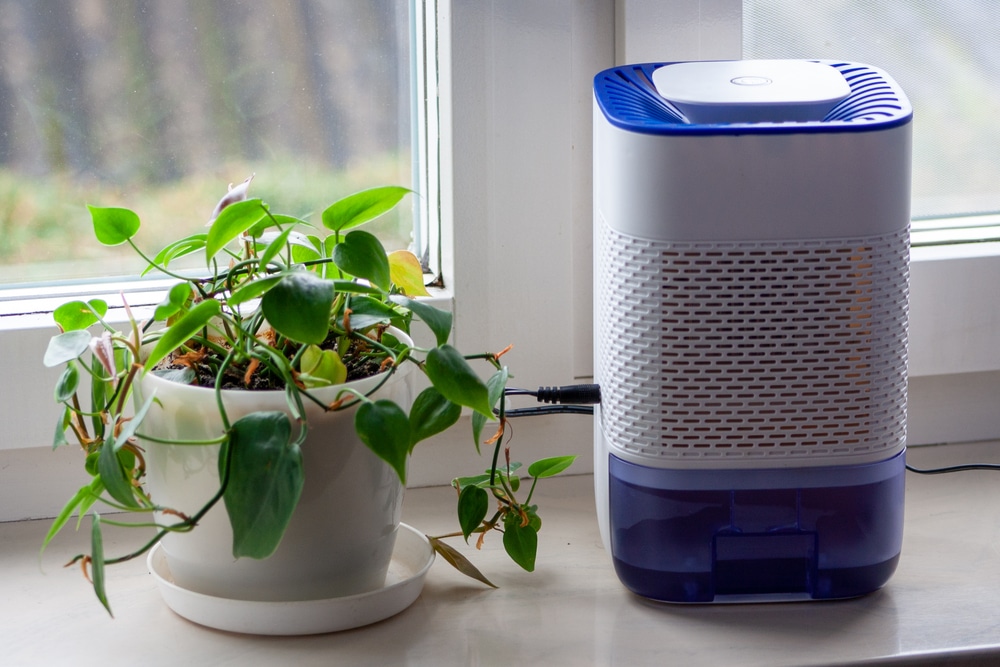Last Updated on January 10, 2023
How much do you know about your dehumidifier? You may know that these devices are designed to reduce the humidity in the air, but most of us don’t know what goes on behind the scenes.
So how does a dehumidifier work? When you switch your home or commercial dehumidifiers on, what happens inside the device that helps to reduce excess moisture? How does it improve your indoor air?
Today, we’re going to take a closer look at dehumidifiers, and what makes them so effective. This could be the perfect article for you if you’re looking into buying a dehumidifier to help with allergies or asthma. You’ll also find this article useful if you’re interested in learning more about your device.
What Is a Dehumidifier?
Dehumidifiers are devices that remove excess moisture from the air. By reducing the relative humidity in enclosed spaces, these appliances improve indoor air quality for homeowners.
If you suffer from allergies or asthma, it might assist you in relieving common symptoms. Dehumidifiers can lessen itchiness, eye irritation, sneezing, chest pain, and wheezing. You can also use these devices to reduce allergy triggers like dust mites, animal dander, pollen, and mould.
I’m a man of my word. Bought a Panosonic dehumidifier from Yodobashi Camera today. Begone from this house forever humidity and mold. pic.twitter.com/fljLoMMxNa
— Oliver Jia (オリバー・ジア) (@OliverJia1014) November 29, 2019
A dehumidifier may have a slightly different performance depending on the kind of product you buy. The dehumidification process can vary from one product to the next, so it’s worth checking the details of each product before you buy it for your room.
How Does a Dehumidifier Work?
Dehumidifiers are often easy to run, energy-efficient, and do a good job of improving the quality of the air in virtually any property. A good dehumidifier can protect you from things like condensation. In addition, they’ll work regardless of whether you have a room filled with fish tanks or a relatively dry space. The best dehumidifiers can work in warm air, or in the cold too.
Dehumidifiers work by pulling excess moisture out of the air, combatting things like mould growth, condensation, and dampness. The performance of your dehumidifier will depend on the kind of product you choose. You can either have a refrigerant dehumidifier, also known as a compressor dehumidifier, or a desiccant dehumidifier.
Refrigerant or compressor dehumidifiers pull the moisture from the air by drawing air in through a filter, over cold coils. The water condenses on the cold coils from the air stream evaporator, dripping into the water tank below. The combination of warm air and a cold surface is extremely effective.
This kind of dehumidifier is better used in warm rooms than in an unheated room. In a cold room, the water decreases due to the lack of condensation options. If a room gets too cold, the cold coil could also begin to freeze. This harms the condensation process and pushes your tank into defrost mode, which spends time and energy to get the system back to the right temperature.
Using desiccant dehumidifiers for continuous drainage of water from the air works slightly differently. They work by pulling water from the indoor air into an absorbent surface or material. The material surface is then heated with an evaporator to ensure water can drip into the reservoir.
Because desiccant dehumidifiers aren’t dependent on any temperature, they work well in all kinds of temperature settings. These dehumidifiers will work even when you have the gas turned up, or no gas heating at all. This could make this kind of dehumidifier better for your garage and other unheated environments. It’s a lot like using some silica gel to prevent mould on your walls and clothes.
How Much Water Should a Dehumidifier Collect in a Day?
 The level of water that your dehumidifier should process in a day will depend on several factors. If you’re using a coil-based dehumidifier with a condenser, then your device’s efficacy will depend on the warmth of the room. If your room is too cold, the device won’t be able to collect the moisture in the air as well and could release it back into the room.
The level of water that your dehumidifier should process in a day will depend on several factors. If you’re using a coil-based dehumidifier with a condenser, then your device’s efficacy will depend on the warmth of the room. If your room is too cold, the device won’t be able to collect the moisture in the air as well and could release it back into the room.
If you’re going to be using your dehumidifier in a cold space, then you might need to choose a desiccant product for a better result. It’s also worth noting that some dehumidifiers have different sizes of tanks. Check the advertising on the condensate or desiccant dehumidifier to avoid having a problem with a large amount of water in your system. You shouldn’t allow the water to fill too high, as this could stop you from managing your humidity levels correctly.
The numbers that are quoted in the advertising for your dehumidifier should refer to the relative humidity that the device can pull from the air at a maximum range in ideal conditions. For instance, some dehumidifiers working at room temperature can pull between 6 and 20 litres of water from your indoor air in a single day. Other devices have much higher extraction rates. If your evaporator system within the dehumidifier is running out of gas (so to speak), it may not work as well.
How Long Does It Take a Dehumidifier to Work?
The time it takes to see results from your dehumidifier depends on several factors. These factors include air temperature, the relative humidity of the room, whether you’re running any air conditioners, and what kind of moisture sources are in the property.
If you’re using your device for the first time, it could take up to 12 hours for your device to begin working properly. The level of performance you see from your condenser during this time will depend on the kind of model you have.
Don’t be surprised if your machine doesn’t seem to work as well as other methods you’ve seen for removing moisture from the air at first. This probably doesn’t have anything to do with the health of your device, its motor, or its coils. Give your homes’ system a chance to warm up. Also, be aware that energy consumption might be higher initially.
Should You Be Using a Dehumidifier?
Investing in a product to remove moisture from your indoor air through coils, silicate, and fan motors might seem a little daunting for homeowners. However, a lot of people believe that a dehumidifier is an important product. Just like you use a fan to put cool air back into the room when it’s too warm, you can use a dehumidifier to remove excess moisture that might cause mould on the surface of your furniture.
A good dehumidifier is generally a good idea if you’re constantly using a fan to get rid of excess moisture in your rooms, or you feel as though it’s too sticky when it’s warm.
You might use an air dehumidifier if you have an old heat pump that produces a lot of moisture. It will be handy if you have trouble getting your home temperature just right, even when you’re using a fan or an air conditioner. You should consider using one if:
- You struggle to control room temperature because of the humidity in the air
- Your windows and belongings have a low dew point causing moisture to gather
- Warm air constantly causes water to evaporate and leave damp spots in your home
- You’re noticing that moisture in the air is problematic to your health
- The excessive humidity in your immediate surroundings leading to mould growth.
Final Thoughts
Knowing exactly how does a dehumidifier work can ensure you make the right decision for your home. We hope that this guide has been useful to you.
Are you using a dehumidifier at home? How’s your experience with your equipment? Let us know any advice you can give in the comments below.
Rebekah is a writer who loves to explore new products and find hacks that make life easier. She has a knack for all things home improvement, health and fitness. So you’ll often find her on Pinterest or browsing Houzz for ideas.
She’s always looking for the next thing to fix up around the house or what gadget might be just right for her lifestyle. Rebekah enjoys exploring new recipes, taking care of her family, and making sure she stays healthy with regular workouts at the gym.

